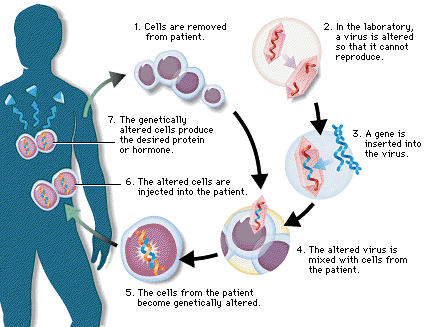What is gene therapy? Gene therapy is an experimental technique used in treatment of malfunctioning genes, whereby a deficient or defective gene is replaced by a working gene, so that the body can make the proper enzyme or protein and as a result eliminate the origin of the disease. Gene therapy is therefore targeted to "genetic metabolic diseases" in which a faulty gene causes an enzyme to be either absent or ineffective in catalyzing a particular metabolic reaction effectively (Citation 76). Approaches for Correcting Defective Genes: 1) The most common approach is inserting a gene into a non-specific location within the genome, replacing a nonfunctional gene. 2) Through selective reverse mutation, the malformed gene can be repaired to attain its normal role. 3) Via homologous recombination, the normal gene is exchanged for the abnormal gene. 4) Alteration of the regulation of a particular gene |  |
 (Citation 76). | How does gene therapy work? In most gene therapy studies, a "normal" gene is inserted into the genome to replace an "abnormal," disease-causing gene. A carrier molecule called a vector must be used to deliver the therapeutic gene to the patient's target cells. Currently, the most common vector is a virus that has been genetically altered to carry normal human DNA. Viruses have evolved a way of encapsulating and delivering their genes to human cells in a pathogenic manner. Scientists have tried to take advantage of this capability and manipulate the virus genome to remove disease-causing genes and insert therapeutic genes (Citation 77). Target cells such as the patient's liver or lung cells are infected with the viral vector. The vector then unloads its genetic material containing the therapeutic human gene into the target cell. The generation of a functional protein product from the therapeutic gene restores the target cell to a normal state (Citation 77). |
Types of Viruses Used in Gene Therapy:
There are 6 main types of viruses used in gene therapy:
1) Retroviruses - A class of viruses that can create double-stranded DNA copies of their RNA genomes. These copies of its genome can be integrated into the chromosomes of host cells. Human immunodeficiency virus (HIV) is a retrovirus.
2) Adenoviruses - A class of viruses with double-stranded DNA genomes that cause respiratory, intestinal, and eye infectious in humans. The virus that causes the common cold is an adenovirus.
3) Adeno-associated viruses - A class of small, single-stranded DNA viruses that can insert their genetic material at a specific site on chromosome 19.
4) Herpes simplex viruses - A class of double-stranded DNA viruses that infect a particular cell type, neurons. Herpes simplex virus type 1 is a common human pathogen that causes cold sores.
5) Alphaviruses - A single stranded positive sense RNA, particularly used to develop viral vectors for the Ross-River virus, Sindbis virus, Semlik Forest virus and Venezuelan Equine Encephalitis virus.
6) Vaccina or pox viruses - A large, complex, enveloped virus belonging to the poxvirus family. It has a linear, double-stranded DNA genome of approximately 190 kb in length, which encodes for around 250 genes. Can accept as much as 25 kb of foreign DNA making it especially useful in expressing a large gene in gene therapy.
Non-Viral Options
The simplest option of non-viral insertion of DNA into the target cells involves direct insertion of the therapeutic cells into the target. This method poses some problems however, due to the large amount of DNA needed and can only be used with specific tissue types.
Another option is of a non-viral approach is the use of therapeutic DNA that chemically links to the DNA to special receptors on the target cells' molecules. The DNA binds to the receptors, and the cell membrane engulfs the cell DNA and transfers it to the interior of the targeted cell. However the delivery system of this option is not very successful.
A liposome (an artificial lipid sphere with an aqueous core) can also be used to transfer the therapeutic DNA to the target cell through the cell's membrane.
